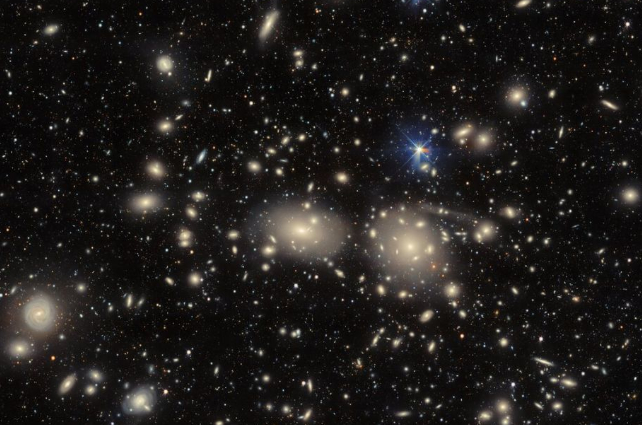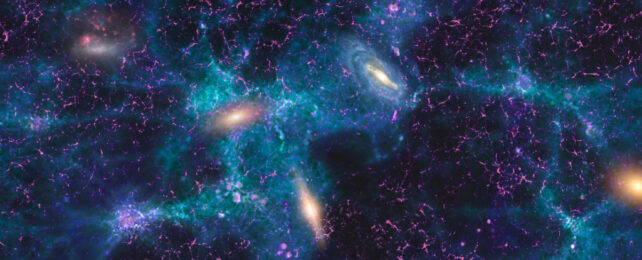Scientists have confirmed the space around us appears to be growing faster than physics can explain, based off precise measurements of a galaxy cluster over 300 million light-years away.
For the better part of a century, astronomers have understood that what started as a concentration of mass and energy crammed into a confined space is now a dazzling spread of galaxies cast adrift on an expanding sea of nothingness.
How it came to be that way depends on physics we barely understand, of inflationary quantum fields overcoming a remarkably weak gravitational force, of a repulsive energy so mysterious we can only describe it as dark, and an equally strange form of attraction which also defies easy explanation.
Putting it all together, we're left with a model of an expanding cosmos that is dotted fairly evenly with slow clumps of matter we can see and some we can't, pushed predictably apart at an estimated rate known as the Hubble constant.
To check our sums, we merely need to look around us and measure the speed at which those clumps of matter are receding into the distance.
There's just one thing. Different methods for measuring the Hubble constant provide different results, giving rise to a 'tension' in cosmology that's once again been confirmed as a serious problem.
"The tension now turns into a crisis," says Dan Scolnic from Duke University, a physicist who led a team in double-checking measurements of a nearby galaxy cluster.
Data from the Dark Energy Spectroscopic Instrument had been used in a previous study to measure the relationship between the stretching of space and precise distance to the Coma cluster, a concentration of more than 1,000 known galaxies estimated to be roughly 320 million light-years away.

Knowing this relationship with confidence is helpful in making similar calculations on further points in space, effectively forming a ladder of measurements stretching ever further into the retreating distance.
"The DESI collaboration did the really hard part, their ladder was missing the first rung," says Scolnic.
"I knew how to get it, and I knew that that would give us one of the most precise measurements of the Hubble constant we could get, so when their paper came out, I dropped absolutely everything and worked on this non-stop."
Scolnic and his team used the spectrum of wavelengths and intensities from the galaxies that matched those of a dozen Type Ia supernovae; the radiant death throes of stars blazing in a characteristic fashion that makes their distance clear.
Using these markers, the team confirmed the Coma cluster to be 321 million light-years away, more or less in the very center of the range of previous estimates.
Having greater confidence in this distance equals greater confidence in calculations on the rate at which the space between here and there is expanding, a speed of 76.5 kilometers per second per megaparsec – not too far off similar cosmic measures based on how we think stars should glow in the near distance.
Unfortunately this is a very different number to measures based on the stretching of ancient light left from the dawn of time after eons of expansion, a far slower 67.4 kilometers per second per megaparsec.
Exactly why this discrepancy exists is one of the greatest conundrums of modern cosmology. By finding new ways to refine each method, it's hoped we'll either identify a critical misassumption that resolves the conflict, or reveal new physics that casts the problem in a new light.
Either way, it's a challenge that's not about to vanish any time soon.
"We're at a point where we're pressing really hard against the models we've been using for two and a half decades, and we're seeing that things aren't matching up," says Scolnic.
"This may be reshaping how we think about the Universe, and it's exciting! There are still surprises left in cosmology, and who knows what discoveries will come next?"
This research was published in The Astrophysical Journal Letters.
